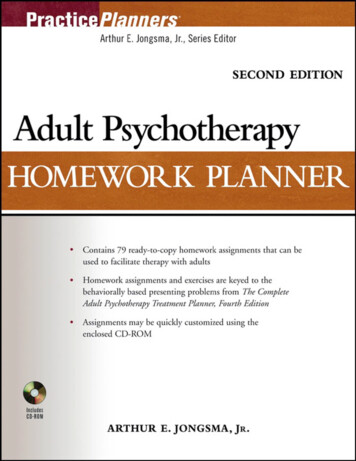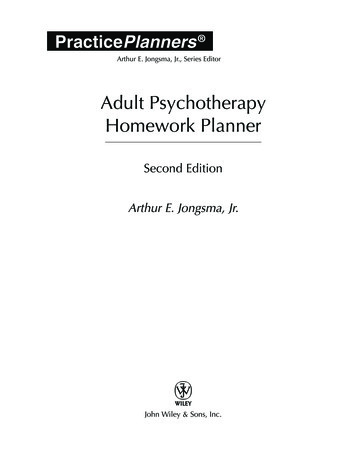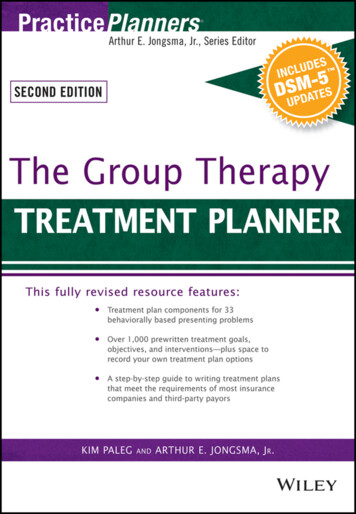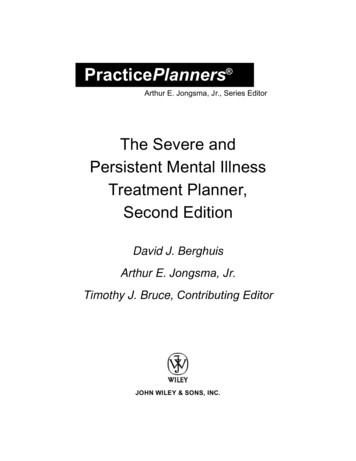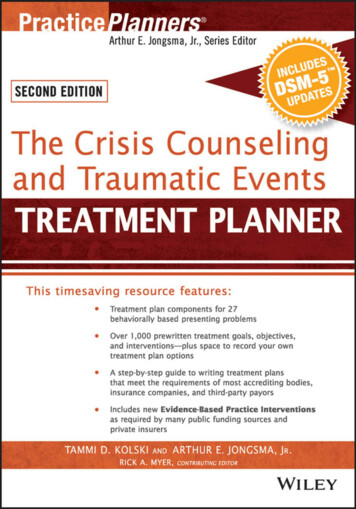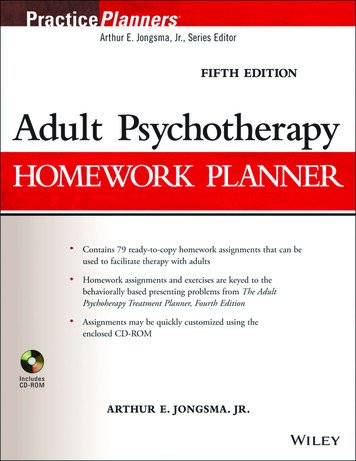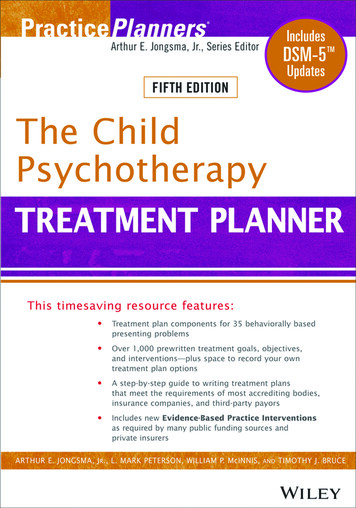
Transcription
The Child PsychotherapyTreatment Planner,Fifth Edition
PracticePlanners SeriesTreatment PlannersThe Complete Adult Psychotherapy Treatment Planner, Fifth EditionThe Child Psychotherapy Treatment Planner, Fifth EditionThe Adolescent Psychotherapy Treatment Planner, Fifth EditionThe Addiction Treatment Planner, Fifth EditionThe Continuum of Care Treatment PlannerThe Couples Psychotherapy Treatment Planner, Second EditionThe Employee Assistance Treatment PlannerThe Pastoral Counseling Treatment PlannerThe Older Adult Psychotherapy Treatment Planner, Second EditionThe Behavioral Medicine Treatment PlannerThe Group Therapy Treatment PlannerThe Gay and Lesbian Psychotherapy Treatment PlannerThe Family Therapy Treatment Planner, Second EditionThe Severe and Persistent Mental Illness Treatment Planner, Second EditionThe Mental Retardation and Developmental Disability Treatment PlannerThe Social Work and Human Services Treatment PlannerThe Crisis Counseling and Traumatic Events Treatment Planner, Second EditionThe Personality Disorders Treatment PlannerThe Rehabilitation Psychology Treatment PlannerThe Special Education Treatment PlannerThe Juvenile Justice and Residential Care Treatment PlannerThe School Counseling and School Social Work Treatment Planner, Second EditionThe Sexual Abuse Victim and Sexual Offender Treatment PlannerThe Probation and Parole Treatment PlannerThe Psychopharmacology Treatment PlannerThe Speech-Language Pathology Treatment PlannerThe Suicide and Homicide Treatment PlannerThe College Student Counseling Treatment PlannerThe Parenting Skills Treatment PlannerThe Early Childhood Intervention Treatment PlannerThe Co-Occurring Disorders Treatment PlannerThe Complete Women’s Psychotherapy Treatment PlannerThe Veterans and Active Duty Military Psychotherapy Treatment PlannerProgress Notes PlannersThe Child Psychotherapy Progress Notes Planner, Fifth EditionThe Adolescent Psychotherapy Progress Notes Planner, Fifth EditionThe Adult Psychotherapy Progress Notes Planner, Fifth EditionThe Addiction Progress Notes Planner, Fifth EditionThe Severe and Persistent Mental Illness Progress Notes Planner, Second EditionThe Couples Psychotherapy Progress Notes Planner, Second EditionThe Family Therapy Progress Notes Planner, Second EditionThe Veterans and Active Duty Military Psychotherapy Progress Notes PlannerHomework PlannersCouples Therapy Homework Planner, Second EditionFamily Therapy Homework Planner, Second EditionGrief Counseling Homework PlannerGroup Therapy Homework PlannerDivorce Counseling Homework PlannerSchool Counseling and School Social Work Homework Planner, Second EditionChild Therapy Activity and Homework PlannerAddiction Treatment Homework Planner, Fifth EditionAdolescent Psychotherapy Homework Planner, Fifth EditionAdult Psychotherapy Homework Planner, Fifth EditionChild Psychotherapy Homework Planner, Fifth EditionParenting Skills Homework PlannerVeterans and Active Duty Military Psychotherapy Homework PlannerClient Education Handout PlannersAdult Client Education Handout PlannerChild and Adolescent Client Education Handout PlannerCouples and Family Client Education Handout PlannerComplete PlannersThe Complete Depression Treatment and Homework PlannerThe Complete Anxiety Treatment and Homework Planner
PracticePlanners Arthur E. Jongsma, Jr., Series EditorThe Child PsychotherapyTreatment Planner,Fifth EditionArthur E. Jongsma, Jr.L. Mark PetersonWilliam P. McInnisTimothy J. Bruce
Cover image: Ryan McVay/Getty ImagesCover design: WileyThis book is printed on acid-free paper.Copyright 2014 by Arthur E. Jongsma, Jr., L. Mark Peterson, William P. McInnis, and Timothy J.Bruce. All rights reserved.Published by John Wiley & Sons, Inc., Hoboken, New JerseyPublished simultaneously in CanadaNo part of this publication may be reproduced, stored in a retrieval system, or transmitted in any form orby any means, electronic, mechanical, photocopying, recording, scanning, or otherwise, except aspermitted under Section 107 or 108 of the 1976 United States Copyright Act, without either the priorwritten permission of the Publisher, or authorization through payment of the appropriate per-copy fee tothe Copyright Clearance Center, 222 Rosewood Drive, Danvers, MA 01923, (978) 750-8400, fax (978)646-8600, or on the web at www.copyright.com. Requests to the Publisher for permission should beaddressed to the Permissions Department, John Wiley & Sons, Inc., 111 River Street, Hoboken, NJ07030, (201) 748-6011, fax (201) 748-6008, or online at www.wiley.com/go/permissions.Limit of Liability/Disclaimer of Warranty: While the publisher and author have used their best efforts inpreparing this book, they make no representations or warranties with respect to the accuracy orcompleteness of the contents of this book and specifically disclaim any implied warranties of merchantabilityor fitness for a particular purpose. No warranty may be created or extended by sales representatives orwritten sales materials. The advice and strategies contained herein may not be suitable for your situation.You should consult with a professional where appropriate. Neither the publisher nor the author shall beliable for damages arising herefrom.For general information about our other products and services, please contact our Customer CareDepartment within the United States at (800) 762-2974, outside the United States at (317) 572-3993 or fax(317) 572-4002.Wiley publishes in a variety of print and electronic formats and by print-on-demand. Some materialincluded with standard print versions of this book may not be included in e-books or in print-on-demand.If this book refers to media such as a CD or DVD that is not included in the version you purchased, youmay download this material at http://booksupport.wiley.com. For more information about Wileyproducts, visit www.wiley.com.Library of Congress Cataloging-in-Publication Data:Jongsma, Arthur E., Jr., 1943–The adolescent psychotherapy treatment planner / Arthur E. Jongsma, Jr., L. Mark Peterson, William P.McInnis, Timothy J. Bruce.—Fifth edition.pages cmIncludes bibliographical references and index.ISBN 978-1-118-06785-7 (pbk. : alk. paper)ISBN 978-1-118-41590-0 (ebk.)ISBN 978-1-118-41888-8 (ebk.)1. Child psychotherapy. 2. Adolescent psychotherapy. I. Peterson, L. Mark. II. McInnis, William P. III.Bruce, Timothy J. IV. Title.RJ504.J664 2014618.92'8914—dc232013030812Printed in the United States of America10 9 8 7 6 5 4 3 2 1
To my daughters and sons-in law, Kendra and Erwin van Elst andMichelle and David DeGraaf, who give themselves creatively andsacrificially to the task of parenting my grandchildren: Tyler, Kaleigh,Justin, and Carter.—A.E.J.To Zach and Jim, who have expanded and enriched my life.—L.M.P.To my three children, Breanne, Kelsey, and Andrew,for the love and joy they bring into my life.—W.P.M.To Lori, Logan, and Madeline, for everything.—T.J.B.
CONTENTSPracticePlanners Series PrefaceAcknowledgmentsIntroductionSample Treatment Planxixiii110Academic UnderachievementAdoptionAnger Control ProblemsAnxietyAttachment DisorderAttention-Deficit/Hyperactivity Disorder (ADHD)Autism Spectrum DisorderBlended FamilyBullying/Intimidation PerpetratorConduct -SeekingDivorce ReactionEnuresis/EncopresisFire SettingGender Identity DisorderGrief/Loss UnresolvedIntellectual Development DisorderLow Self-EsteemLying/ManipulativeMedical ConditionObsessive-Compulsive Disorder (OCD)Oppositional DefiantOverweight/ObesityParentingPeer/Sibling ConflictPhysical/Emotional Abuse VictimPosttraumatic Stress Disorder (PTSD)School 8219230242255267279294307320330340354ix
xCONTENTSSeparation AnxietySexual Abuse VictimSleep DisturbanceSocial AnxietySpecific PhobiaSpeech/Language Disorders367380391402414425Appendix A Bibliotherapy SuggestionsAppendix B Professional References forEvidence-Based ChaptersAppendix C Other Professional References for Selected ChaptersAppendix D Index of Therapeutic Games, Workbooks,Toolkits, DVDs, Videotapes, and AudiotapesAppendix E Recovery Model Objectives and InterventionsAppendix F Alphabetical Index of Sources for AssessmentInstruments and Clinical Interview Forms Cited in Interventions436460490494496503
PRACTICEPLANNERS SERIES PREFACEAccountability is an important dimension of the practice of psychotherapy.Treatment programs, public agencies, clinics, and practitioners must justifyand document their treatment plans to outside review entities in order to bereimbursed for services. The books in the PracticePlanners series are designedto help practitioners fulfill these documentation requirements efficiently andprofessionally.The PracticePlanners series includes a wide array of treatment planningbooks including not only the original Complete Adult PsychotherapyTreatment Planner, Child Psychotherapy Treatment Planner, and AdolescentPsychotherapy Treatment Planner, all now in their fifth editions, but alsoTreatment Planners targeted to specialty areas of practice, including: AddictionsCo-occurring disordersBehavioral medicineCollege studentsCouples therapyCrisis counselingEarly childhood educationEmployee assistanceFamily therapyGays and lesbiansGroup therapyJuvenile justice and residential careMental retardation and developmental disabilityNeuropsychologyOlder adultsParenting skillsPastoral counselingPersonality disordersProbation and parolePsychopharmacologyRehabilitation psychologySchool counseling and school social workSevere and persistent mental illnessSexual abuse victims and offendersxi
xiiPRACTICEPLANNERS SERIES PREFACE Social work and human servicesSpecial educationSpeech-Language pathologySuicide and homicide risk assessmentVeterans and active military dutyWomen’s issuesIn addition, there are three branches of companion books that can be used inconjunction with the Treatment Planners, or on their own: Progress Notes Planners provide a menu of progress statements thatelaborate on the client’s symptom presentation and the provider’stherapeutic intervention. Each Progress Notes Planner statement isdirectly integrated with the behavioral definitions and therapeuticinterventions from its companion Treatment Planner.Homework Planners include homework assignments designed aroundeach presenting problem (such as anxiety, depression, substance use,anger control problems, eating disorders, or panic disorders) that is thefocus of a chapter in its corresponding Treatment Planner.Client Education Handout Planners provide brochures and handouts to helpeducate and inform clients on presenting problems and mental healthissues, as well as life skills techniques. The handouts are included on CDROMs for easy printing from your computer and are ideal for use inwaiting rooms, at presentations, as newsletters, or as information for clientsstruggling with mental illness issues. The topics covered by these handoutscorrespond to the presenting problems in the Treatment Planners.The series also includes adjunctive books, such as The PsychotherapyDocumentation Primer and The Clinical Documentation Sourcebook, whichcontain forms and resources to aid the clinician in mental health practicemanagement.The goal of our series is to provide practitioners with the resources theyneed in order to provide high-quality care in the era of accountability. Toput it simply: We seek to help you spend more time on patients, and less timeon paperwork.ARTHUR E. JONGSMA, JR.Grand Rapids, Michigan
ACKNOWLEDGMENTSSince 2005, we have turned to research evidence to inform the treatmentObjectives and Interventions in our latest editions of the PsychotherapyTreatment Planner books. While much of the content of our Planners was“best practice” and also from the mainstream of sound psychologicalprocedure, we have benefited significantly from a thorough review thatlooked through the lens of evidence-based practice. The later editions of thePlanners now stand as content not just based on “best practice” but based onreliable research results. Although several of my coauthors have contributedto this recertification of our content, Timothy J. Bruce has been the mainguiding force behind this effort. I am very proud of the highly professionalcontent provided by so many coauthors who are leaders in their respectivesubspecialties in the field of psychology such as addiction, family therapy,couples therapy, personality disorder treatment, group treatment, women’sissues, military personnel treatment, older adult treatment, and many others.Added to this expertise over the past seven years has been the contributionof Dr. Tim Bruce who has used his depth of knowledge regarding evidencesupported treatment to shape and inform the content of the last two editions,Adult, Adolescent, Child, and Addiction Psychotherapy Treatment Planners. Iwelcome Tim aboard as an author for these books and consider it an honorto have him as a friend, colleague, and coauthor.I must also add my acknowledgment of the supportive professionalismof the Wiley staff, especially that of my editor, Marquita Flemming. Wileyhas been a trusted partner in this series for almost 20 years now and I amfortunate to be published by such a highly respected company. Thank you toall my friends at Wiley!And then there is our manuscript manager, Sue Rhoda, who knows justwhat to do to make a document presentable, right up to the standardsrequired by a publisher. Thank you, Sue.Finally, I tip my hat to my coauthors, Mark Peterson and Bill McInnis,who launched this Child Psychotherapy Treatment Planner with their originalxiii
xiv ACKNOWLEDGMENTScontent contributions many years ago and have supported all the efforts tokeep it fresh and evidence-based.AEJI am fortunate to have been invited some seven years ago by Dr. ArtJongsma to work with him on his well-known and highly regardedPsychotherapy Treatment Planner series and to now be welcomed as one ofhis coauthors on this Planner along with Mark Peterson and Bill McInnis.As readers know, Art’s treatment planners are highly regarded as works ofenormous value to practicing clinicians as well as terrific educational toolsfor “students” of our profession. That Art’s brainchild would have this typeof value to our field is no surprise when you work with him. He is theconsummate psychologist, with enormous breadth and depth of experience,a profound intellect, and a Rogerian capacity for empathy andunderstanding—all of which he would modestly deny. When you work withArt, you not only get to know him, you get to know his family, colleagues,and friends. In doing so, you get to know his values. If you are like me, youhave relationships that you prize because they are with people whom youknow to be, simply stated, good. Well, to use an expression I grew up with,“Art is good people.” And it is my honor to have him as a friend, colleague,and coauthor. Thank you, Art!I also would like to thank Marquita Flemming and the staff at Wiley fortheir immeasurable support, guidance, and professionalism. It is just myopinion, but I think Marquita should publish her own book on authorrelations.I would also like to extend a big thank-you to our manuscript manager,Sue Rhoda, for her exacting work and (needed) patience. In fact, I am sureSue will take it in stride when we ask to do one more edit of thisacknowledgment section after it has been “finalized.”Lastly, I would like to thank my wife, Lori, and our children, Logan andMadeline, for all they do. They’re good people, too.TJB
The Child PsychotherapyTreatment Planner,Fifth Edition
INTRODUCTIONABOUT PRACTICEPLANNERS TREATMENTPLANNERSPressure from third-party payors, accrediting agencies, and other outsideparties has increased the need for clinicians to quickly produce effective,high-quality treatment plans. Treatment Planners provide all the elementsnecessary to quickly and easily develop formal treatment plans that satisfythe needs of most third-party payers and state and federal review agencies.Each Treatment Planner: Saves you hours of time-consuming paperwork.Offers the freedom to develop customized treatment plans.Includes over 1,000 clear statements describing the behavioral manifestations of each relational problem, and includes long-term goals, shortterm objectives, and clinically tested treatment options.Has an easy-to-use reference format that helps locate treatment plancomponents by behavioral problem.As with the rest of the books in the PracticePlanners series, our aim isto clarify, simplify, and accelerate the treatment planning process so youspend less time on paperwork and more time with your clients.ABOUT THIS FIFTH EDITION CHILD PSYCHOTHERAPYTREATMENT PLANNERThis fifth edition of the Child Psychotherapy Treatment Planner has beenimproved in many ways: Updated with new and revised evidence-based Objectives andInterventionsRevised, expanded, and updated the Professional Reference Appendix B1
2 THE CHILD PSYCHOTHERAPY TREATMENT PLANNER Many more suggested homework assignments from the companion book,The Child Psychotherapy Homework Planner, have been integrated intothe InterventionsExtensively expanded and updated self-help book list in the BibliotherapyAppendix ANew Recovery Model Appendix E listing Goals, Objectives, andInterventions allowing the integration of a recovery model orientationinto treatment plansAddition of a chapter on Overweight/ObesityRenamed several chapters: Anger Management is now Anger ControlProblems, Autism/Pervasive Developmental Disorder is now AutismSpectrum Disorder, Mental Retardation is now Intellectual Developmental Disorder, and Social Phobia/Shyness is now Social AnxietyIntegrated DSM-5/ICD-10 diagnostic labels and codes into theDiagnostic Suggestions section of each chapterAdded Appendix C with a listing of other professional references forcited books and articles not referenced in Appendix BAdded Appendix F for listing an index of sources for assessment testsand interview forms cited in the chapter interventionsEvidence-based practice (EBP) is steadily becoming the standard of care inmental healthcare as it has in medical healthcare. Professional organizationssuch as the American Psychological Association, National Association ofSocial Workers, and the American Psychiatric Association, as well asconsumer organizations such as the National Alliance for the Mentally Ill(NAMI), have endorsed the use of EBP. In some practice settings, EBP isbecoming mandated. It is clear that the call for evidence and accountabilityis being increasingly sounded. So, what is EBP and how is its use facilitatedby this Planner?Borrowing from the Institute of Medicine’s definition (Institute ofMedicine, 2001), the American Psychological Association (APA) has definedEBP as “the integration of the best available research with clinical expertisein the context of patient characteristics, culture, and preferences” (APAPresidential Task Force on Evidence-Based Practice, 2006). Consistent withthis definition, we have identified those psychological treatments with thebest available supporting evidence, added Objectives and Interventionsconsistent with them in the pertinent chapters, and identified these with thissymbol: . As most practitioners know, research has shown that althoughthese treatment methods have demonstrated efficacy (e.g., Nathan & Gorman,2007), the individual psychologist (e.g., Wampold, 2001), the treatmentrelationship (e.g., Norcross, 2002), and the patient (e.g., Bohart & Tallman,1999) are also vital contributors to the success of psychotherapy. As notedby the APA, “Comprehensive evidence-based practice will consider all ofthese determinants and their optimal combinations” (APA, 2006, p. 275).For more information and instruction on constructing evidence-based
INTRODUCTION 3psychotherapy treatment plans, see our DVD-based training series entitledEvidence-Based Psychotherapy Treatment Planning (Jongsma & Bruce,2010–2012).The sources listed in the Professional Reference Appendix B and used toidentify the evidence-based treatments integrated into this Planner are many.They include supportive studies from the psychotherapy outcome literature,current expert individual, group, and organizational reviews, as well asevidence-based practice guideline recommendations. Examples of specificsources used include the Cochrane Collaboration reviews, the work of theSociety of Clinical Psychology (Division 12 of the American PsychologicalAssociation), and the Society of Clinical Child and Adolescent Psychology(Division 53 of the American Psychological Association) identifyingresearch-supported psychological treatments, evidence-based treatmentreviews such as those in Nathan and Gorman’s A Guide to Treatments ThatWork (2007) and Weisz and Kazdin’s Evidence-Based Psychotherapies forChildren and Adolescents (2010), as well as evidence-based practice guidelinesfrom professional organizations such as the American PsychiatricAssociation, the American Academy of Child & Adolescent Psychiatry, theNational Institute for Health and Clinical Excellence in Great Britain, TheNational Institute on Drug Abuse (NIDA), the Substance Abuse and MentalHealth Services Administration (SAMHSA), and the Agency for HealthcareResearch and Quality (AHRQ), to name a few.Although each of these sources uses its own criteria for judging levels ofempirical support for any given treatment, we favored those that use morerigorous criteria typically requiring demonstration of efficacy throughrandomized controlled trials or clinical replication series, good experimentaldesign, and independent replication. Our approach was to evaluate thesevarious sources and include those treatments supported by the highest levelof evidence and for which there was consensus in conclusions/recommendations. For any chapter in which EBP is identified, references tothe sources used are listed in the Professional References Appendix B, andcan be consulted by those interested for further information regardingcriteria and conclusions. In addition to these references, this appendix alsoincludes references to Clinical Resources. Clinical Resources are books,manuals, and other resources for clinicians that describe the details of theapplication, or “how to” of the treatment approaches described in a chapter.There is debate regarding evidence-based practice among mental healthprofessionals who are not always in agreement regarding the best treatmentor how to weigh the factors that contribute to good outcomes. Somepractitioners are skeptical about changing their practice on the basis ofresearch evidence, and their reluctance is fueled by the methodologicalchallenges and problems inherent in psychotherapy research. Our intent inthis book is to accommodate these differences by providing a range oftreatment plan options, some supported by the evidence-based value of “bestavailable research,” others reflecting common clinical practices of
4 THE CHILD PSYCHOTHERAPY TREATMENT PLANNERexperienced clinicians, and still others representing emerging approaches sothe user can construct what they believe to be the best plan for theirparticular client.Each of the chapters in this edition has also been reviewed with the goalof integrating homework exercise options into the Interventions. Many (butnot all) of the client homework exercise suggestions were taken from and canbe found in the Child Psychotherapy Homework Planner (Jongsma, Peterson,& McInnis, 2014). You will find many more homework assignmentssuggested for your consideration as part of the Intervention process in thisfifth edition of the Child Psychotherapy Treatment Planner than in previouseditions.The Bibliotherapy Suggestions Appendix A of this Planner has beensignificantly expanded and updated from previous editions. It includes manyrecently published offerings as well as more recent editions of books cited inour earlier editions. All of the self-help books and client workbooks cited inthe chapter Interventions are listed in this Appendix. There are also manyadditional books listed that are supportive of the treatment approachesdescribed in the respective chapters. Each chapter has a list of self-helpbooks consistent with it listed in this Appendix.Appendix C lists additional clinical resources for professionals that arenot listed in the evidence-based resources of Appendix B and are cited in thechapters listed in Appendix C. Therapeutic games, workbooks, toolkits,DVDs, and audiotapes that are cited in chapters are referenced in AppendixD. A new Appendix F provides an alphabetical index of sources forassessment instruments and clinical interview forms cited in interventions.We hope that this index makes it easier for readers to find these resources ifthey are added to the treatment plan.In its final report entitled Achieving the Promise: Transforming MentalHealth Care in America, The President’s New Freedom Commission onMental Health called for recovery to be the “common, recognized outcomeof mental health services” (New Freedom Commission on Mental Health,2003). To define recovery, the Substance Abuse and Mental Health ServicesAdministration (SAMHSA) within the U.S. Department of Health andHuman Services and the Interagency Committee on Disability Research inpartnership with six other Federal agencies convened the NationalConsensus Conference on Mental Health Recovery and Mental HealthSystems Transformation (SAMHSA, 2004). Over 110 expert panelistsparticipated including mental health consumers, family members, providers,advocates, researchers, academicians, managed care representatives,accreditation bodies, state and local public officials, and others. From thesedeliberations, the following consensus statement was derived:“Mental health recovery is a journey of healing and transformation for aperson with a mental health problem to be able to live a meaningful life in acommunity of his or her choice while striving to achieve maximum human
INTRODUCTION 5potential. Recovery is a multifaceted concept based on the following 10fundamental elements and guiding vidualized and hs-basedPeer supportRespectResponsibilityHopeThese principles are defined in Appendix E. We have also created a set ofGoal, Objective, and Intervention statements that reflect these 10 principles.The clinician who desires to insert into the client treatment plan specificstatements reflecting a Recovery Model orientation may choose from thislist.In addition to this list, we believe that many of the Goal, Objective, andIntervention statements found in the chapters reflect a recovery orientation.For example, our assessment interventions are meant to identify how theproblem affects this unique client and the strengths that the client brings tothe treatment. Additionally, an intervention statement such as, “Developwith the client a list of positive affirmations about himself/herself, and askthat it be read three times daily” from the Low Self-Esteem chapter isevidence that recovery model content permeates items listed throughout ourchapters. However, if the clinician desires a more focused set of statementsdirectly related to each principle guiding the recovery model, they can befound in Appendix E.The topic of our children (and adults, too) becoming seriouslyoverweight or obese is getting increasing media and professional attention inrecent years. Because obesity predisposes individuals to an increased risk ofseveral diseases and medical conditions, it is included in the InternationalClassification of Diseases (or ICD) as a general medical condition. It doesnot appear in the DSM because it is not consistently associated with apsychological or behavioral syndrome. It is, however, a highly prevalentmedical issue, influenced by psychological and behavioral factors, and hasproven to be responsive to psychological treatment. Therefore, we haveadded a chapter on Overweight/Obesity to provide evidence-based guidancein developing a treatment plan for this problem. We hope you find thisaddition helpful.We have made a title change for the chapter previously entitled MentalRetardation. Even though the term “mental retardation” was selected about50 years ago to replace what was seen as overly general terminology (e.g.,mental deficiency) or pejorative labels (e.g., idiocy), in recent years the term
6 THE CHILD PSYCHOTHERAPY TREATMENT PLANNERmental retardation has been seen similarly. Instead, we replaced the titleMental Retardation with the title Intellectual Developmental Disorder toimprove specificity and bring our title in line with the latest classificationsystem terminology.With the publication of the DSM-5 (American Psychiatric Association,2013) we have updated the Diagnostic Suggestions listed at the end of eachchapter. The DSM-IV-TR (American Psychiatric Association, 2000) wasused in previous editions of this Planner. Although many of the diagnosticlabels and codes remain the same, several have changed with the publicationof the DSM-5 and are reflected in this Planner.Lastly, some clinicians have asked that the Objective statements in thisPlanner be written such that the client’s attainment of the Objective can bemeasured. We have written our Objectives in behavioral terms and many aremeasurable as written. For example, this Objective from the Anxiety chapteris one that is measurable as written because either it is done or it is not:“Participate in live, or imaginal then live, exposure exercises in which worriesand fears are gradually faced.” But at times the statements are too broad tobe considered measurable. Consider, for example, this Objective from theAnxiety chapter: “Identify, challenge, and replace biased, fearful self-talkwith positive, realistic, and empowering self-talk.” To make it quantifiable aclinician might modify it to read, “Give t
The Child Psychotherapy Progress Notes Planner, Fifth Edition The Adolescent Psychotherapy Progress Notes Planner, Fifth Edition . The Couples Psychotherapy Progress Notes Planner, Second Edition The Family Therapy Progress Notes Planner, Second Edition The Veterans and Active Duty Military Psychotherapy Progress Notes Planner Homework Planners

